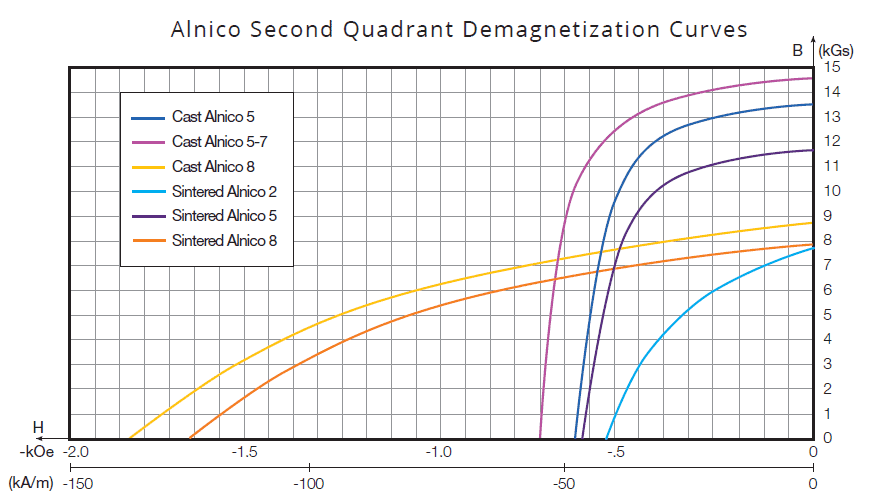Design Considerations
Because Alnico is hard and brittle and not suitable for drilling, tapping or conventional machining operations, it is not usually used as a structural component in product design. We recommend selecting simple shapes when possible, fitting into slots rather than holes. Cross sections of less than .125″ (3.18 mm) should be avoided. Finishing increases cost, so if your application can use “as cast” or “as sintered” then cost will be lower.
For holding applications requiring mounting, or to protect the magnet, alnico assemblies such as rotors or magnetron magnets may be supplied with aluminum housings. Alnico may be painted for aesthetic reasons, like the ever popular red horseshoe magnet.
Demagnetization Curves
A second quadrant demagnetization curve provides information about the magnetic characteristics of a magnet, including the magnetic field strength and how resistant it is to demagnetize. How it is used in a magnetic circuit will affect its performance. When a permanent magnet is fully magnetized, its magnetic domains are aligned. Certain conditions such as temperature and reverse magnetic fields can cause some of the domains to lose this alignment and reverse, triggering the magnet to lose some or all of its magnetic field.
Resources
Adams Stock Products Catalog 2018
We are delighted to share our 2018 catalog with you. We’ve added updated information about our fabrication capabilities, available in Elmhurst, IL and Carlsbad, CA. We’ve also added new neodymium holding assemblies, a MAGbond Magnetic Media System overview, and high energy wide-format magnetic sheet (40″ wide and still printable!). If you’d prefer to receive a hard copy of this catalog, let us know.
Adams Hard Magnet Materials Catalog updated 2020
(7MB) This PDF catalog features a magnet materials overview, chart of materials properties and demagnetization curves for Neodymium, Samarium Cobalt, Ceramic (Ferrite) and Alnico materials offered by Adams. New in 2020, we’ve added more curves, and a coatings chart to assist with corrosion protection decisions.
Chart of Material Properties
Displays each permanent magnet material along with its Maximum Energy Product: Bhmax, Residual Flux Density: Br Gauss, Coercive Force: Hc Oersteds, Intrinsic Coercive Force: Hci Oersteds and Maximum Operating Temperature: C / F.
Breakaway Force of a Magnet
Explains the test methods used to determine how much force it takes to pull a magnet directly away from the surface it is attached to.
Standard Specifications for Permanent Magnet Materials
Defines thermal and mechanical characteristics and properties of commercially available permanent magnet materials including Alnico, Ceramic, Rare Earth (Samarium cobalt and neodymium) and Iron-Chromium-Cobalt. Includes a Glossary of Terms and Magnetic Quantities (Symbols, Units and Conversion Factors).







